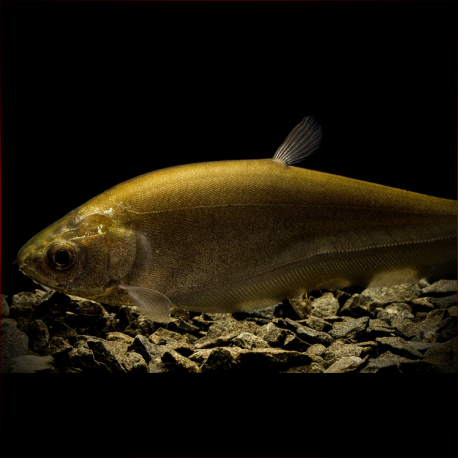Notopterus Notopterus
Osteoglossiformes Print
More info
Datasheet
| Minimum Tank Size | 10000 litres / 2641.72 US gallons |
| Maximum Size | 60.0cm / 23.62inches |
| Temperature | 20°C / 68.00°F - 28°C / 82.40°F |
| Hardness | 2.02dgH / 36ppm - 15.02dgH / 268ppm |
| pH | 6.0-8.0 |
General Description
The Bronze Featherback, scientifically known as Notopterus notopterus, is a species belonging to the Osteoglossiformes order. It is also commonly referred to as the "Asian knifefish" or "ghost knifefish" in the aquarium trade. This species is distinguishable by its large adult size, dorsal fin presence, and plain brown adult coloration with dark vertical bars on juveniles.
Aquarium Setup
The Bronze Featherback thrives in aquarium setups with dim lighting and refuges such as driftwood, large rocks, or plastic piping. It is recommended to have a large, mature filter system, regular water changes of 50-70% tank volume, and highly oxygenated water with some movement. Water conditions should ideally have a hardness of 36-268ppm, a pH range between 6.0-8.0, and a temperature of 20-28°C (see table).
Behaviour
This species is relatively peaceful towards larger tankmates but can exhibit territorial behavior, especially towards conspecifics and similar species in confined spaces. It is primarily nocturnal and is known to be an obligate predator, feeding on smaller fishes, crustaceans, and invertebrates in the wild.
Feeding and Diet
In captivity, the Bronze Featherback adapts well to dead alternatives and can be fed chironomid larvae, earthworms, prawns, shrimp, mussels, and dried pellets. It is essential to avoid feeding them mammalian or avian meat like beef heart or chicken. Live feeder fish are not recommended due to the risk of disease transmission.
Reproduction & Dimorphism
Reproduction behaviors of the Bronze Featherback in aquariums are unrecorded. In the wild, they deposit eggs among submerged vegetation in flooded forest areas during the wet season. Information about sexual dimorphism in this species is currently unreported.
Habitat and Distribution
Bronze Featherbacks are commonly found in the lower parts of rivers, tributaries, swamps, floodplains, and lakes in regions across the Indian subcontinent and Southeast Asia. Their distribution includes countries like Pakistan, India, Nepal, Bangladesh, Myanmar, Cambodia, Malaysia, and Indonesia. They are adaptable to man-made dams and flooded forest areas for spawning purposes.

